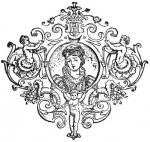Chapter IX.
| " The willow-pattern that we knew
In childhood. with its bridge of blue, Leading to unknown thoroughfares." Keramos, Longfellow. |
 Peradventure some who read these rambling paragraphs may be the fortunate possessor of a few pieces of that willow-pattern, blue or pink china table ware which was but too lightly esteemed when it was a common heritage of English and American families. If not, a vivid remembrance of the ware and of the fancies which it inspired, must be little less prized by those who cherish such associations with home and childhood. We are tempted here to recall some of our own reminiscences of old china, which the impatient reader may excusably skip for more serious matter.
Peradventure some who read these rambling paragraphs may be the fortunate possessor of a few pieces of that willow-pattern, blue or pink china table ware which was but too lightly esteemed when it was a common heritage of English and American families. If not, a vivid remembrance of the ware and of the fancies which it inspired, must be little less prized by those who cherish such associations with home and childhood. We are tempted here to recall some of our own reminiscences of old china, which the impatient reader may excusably skip for more serious matter.
From the semi-aquatic summer-house with roof curving upward like an inverted umbrella, imprinted upon a favorite tea-plate, we often sallied forth in fancy to explore the Chinese world as portrayed in blue or pink upon earthen table-ware of the olden time. And what a world ! How artfully adapted to childish notions, how convenient for bird's-eye views, this arrangement of lofty mountain peaks, deep gorges, and rocks of fantastic forms, tangled up with examples of nature subdued by Chinese art in landscape gardening and ornate architecture. In the near distance (far and near are the same in Chinese art), we behold a slender streak of waterfall descending from mountain peaks a thousand feet or height by comparison; a broad flight of stone stairs leading up to a palace or temple of intricate construction and marvellous ornamentation; a majestic river a mile or two in width, winding serenely by these wonders of nature and art, but submitting to be spanned by a single arch of bridge, perhaps thrice the length of the Chinaman advancing over its camel-humped back, who placidly regards from under his ruffle-edged umbrella the pleasure boats floating beneath him. A little group of high-born Chinese ladies in holiday attire are seated in a garden of potted plants on the river's bank, drinking tea, flirting their fans, and doubtless talking over the latest Court gossip. Nearby is a willow, not the stiff, ugly tree now seen upon tame and degenerate imitations of real old China pottery, but a graceful weeping-willow, * whose drooping branches sweep the opposite shore, as sublimely indifferent to distance as the untrammeled artist himself.
No hint here of imperative human toil, or of human need, or of anything but present enjoyment and rest; it is a picture of contented, comfortable existence, for dreamy contemplation, amid a grouping of art and nature that calmly defies probability and challenges the impossible.
But perhaps the Chinese artist had more justification for his incredible fancies than we have imagined. Strange contradictions occur in China, judged by our conventional standards, and there are surprises and incongruities even in their actual landscapes, which are unsuspected by thousands of our intelligent countrymen. Some examples of such departure from our notions of natural and of artificial scenery are given in the illustrations of this work.


